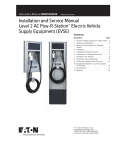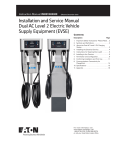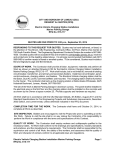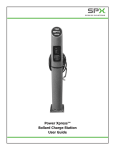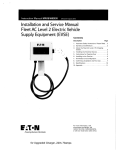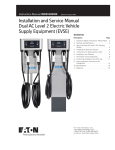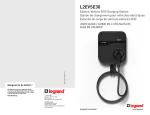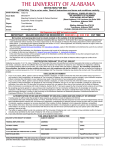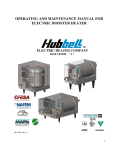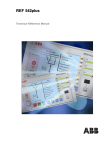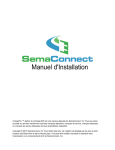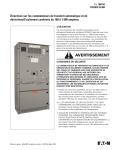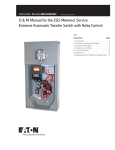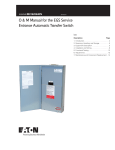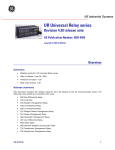Download Installation and Service Manual AC Level 2 Electric Vehicle Supply
Transcript
Instruction Manual IM0EV00002E Effective December 2013 Supercedes November 2012 Installation and Service Manual AC Level 2 Electric Vehicle Supply Equipment (EVSE) Contents DescriptionPage 1. 2. 3. 4. 5. 6. 7. 8. 9. Important Safety Instructions- Please Read . . 2 Symbols and Definitions. . . . . . . . . . . . . . . . . 2 About the AC Level 2 EV Charging Station. . . 3 Installing the Electrical Service. . . . . . . . . . . . 4 Instructions for Opening Door Latch . . . . . . . 5 Installing to the Premise. . . . . . . . . . . . . . . . . 6 Termination and Configuration. . . . . . . . . . . . . 9 Confirming Installation and First Use . . . . . . . 11 Communications Connectivity for ChargePoint . . . . . . . . . . . . . . . . . . . . . . . . . 13 10.Specifications . . . . . . . . . . . . . . . . . . . . . . . . 14 11Appendix. . . . . . . . . . . . . . . . . . . . . . . . . . . . 15 For more information, visit www.eaton.com/plugin, call 1-855-ETN-EVSE (1-855-386-3873), or call your local Eaton sales office. Installation and Service Manual AC Level 2 Electric Vehicle Supply Equipment (EVSE) Instruction Manual IM0EV00002E Effective December 2013 1. Important Safety Instructions - Please Read WARNING ELECTRICAL THIS EQUIPMENT SHOULD BE INSTALLED, ADJUSTED, AND SERVICED BY QUALIFIED ELECTRICAL PERSONNEL FAMILIAR WITH THE CONSTRUCTION AND OPERATION OF THIS TYPE OF EQUIPMENT AND THE HAZARDS INVOLVED. FAILURE TO OBSERVE THIS PRECAUTION COULD RESULT IN DEATH OR SEVERE INJURY READ THIS MANUAL THOROUGHLY AND MAKE SURE YOU UNDERSTAND THE PROCEDURES BEFORE YOU ATTEMPT TO OPERATE THIS EQUIPMENT. THE PURPOSE OF THIS MANUAL IS TO PROVIDE YOU WITH INFORMATION NECESSARY TO SAFELY OPERATE, MAINTAIN, AND TROUBLESHOOT THIS EQUIPMENT. KEEP THIS MANUAL FOR FUTURE REFERENCE. DO NOT USE THIS PRODUCT IF THE EV CABLE IS FRAYED, HAS DAMAGED INSULATION OR ANY OTHER SIGN OF DAMAGE. DO NOT USE THIS PRODUCT IF THE ENCLOSURE OR THE EV CONNECTOR IS BROKEN, CRACKED, OPEN, OR SHOWS ANY OTHER INDICATION OF DAMAGE. INTENDED FOR USE WITH PLUG-IN ELECTRIC VEHICLES ONLY. PREMISE VENTILATION NOT REQUIRED. DO NOT DRILL HOLES OR MODIFY ENCLOSURE SUCH THAT THE NEMA/IP RATINGS ARE COMPROMISED. THE INFORMATION CONTAINED IN THIS MANUAL IS SUBJECT TO CHANGE WITHOUT NOTICE. 2. Symbols and Definitions WARNING ELECTRICAL THIS SYMBOL INDICATES HIGH VOLTAGE. IT CALLS YOUR ATTENTION TO ITEMS OR OPERATIONS THAT COULD BE DANGEROUS TO YOU AND OTHER PERSONS OPERATING THIS EQUIPMENT. READ THE MESSAGE AND FOLLOW THE INSTRUCTIONS CAREFULLY. WARNING INDICATES A POTENTIALLY HAZARDOUS SITUATION WHICH, IF NOT AVOIDED, CAN RESULT IN SERIOUS INJURY OR DEATH. CAUTION INDICATES A POTENTIAL HAZARDOUS SITUATION WHICH, IF NOT AVOIDED, CAN RESULT IN MINOR TO MODERATE INJURY, OR SERIOUS DAMAGE TO THE EQUIPMENT. THE SITUATION DESCRIBED IN THE CAUTION MAY, IF NOT AVOIDED, LEAD TO SERIOUS RESULTS. IMPORTANT SAFETY MEASURES ARE DESCRIBED IN CAUTION (AS WELL AS WARNING). IMPORTANT INDICATES A PARTICULAR ITEM OR INSTRUCTION THIS IS IMPORTANT TO CONSIDER. Save These Instructions 2 EATON CORPORATION www.eaton.com Definitions AC – Alternating Current. The type of power available in most buildings and on utility poles. The Level 2 EVSE protects Users and vehicles by allowing AC power to flow through it to the vehicle. The vehicle then converts the AC to DC (Direct Current) to charge the traction battery. ADA – Americans with Disabilities ACT. ALC – Available Line Current. The charger tells the vehicle through the J1772™ connector’s pilot pin how much current (in amperes) it is allowed to pull on the circuit. This allows the car to not exceed the circuit’s maximum current rating. EVSE – Electric Vehicle Supply Equipment. EVSE is a general term used for all of the equipment used to supply electricity to the car, such as the Eaton AC Level 2 EVSE. GFCI – Ground Fault Current Interrupter. GFCI protects Users from faults involving leakage currents going to ground, rather than the proper return path of the circuit. J1772™ – The SAE Recommended Practice for conductive charging of hybrid and electric vehicles. This standard spells out the physical dimensions of the J1772 connector and the pilot communication between the plug-in vehicle and EVSE. Pilot – The signal through the J1772 connector. This signal tells both the vehicle and the EVSE when both are ready to charge and how much current it is allowed to pull. This signal is a SAE standard. Plug Session – The time while the EVSE is plugged into a vehicle. It starts by plugging in the J1772 connector and ends when unplugging the same connector. SAE – Society of Automotive Engineers. The group that organizes and leads committees of transportation experts to create standards, such as J1772, for the transportation industry. TB – The Terminal Block is where the incoming field power will be terminated in the EVSE unit. Traction Battery – The large battery on a plug-in electric vehicle that is used to store and release energy for propulsion. This is different than the 12V battery that is used to start the vehicle initially and run accessories such as the radio. UI – The User Interface part of the unit. Installation and Service Manual AC Level 2 Electric Vehicle Supply Equipment (EVSE) 3. About the AC Level 2 EV Charging Station Eaton’s AC Level 2 charging station is Electric Vehicle Supply Equipment (EVSE) and is compatible with the Society of Automotive Engineers J1772™ standard for charging plug-in hybrid and all-electric vehicles. The Level 2 EV Charging Station has several safety features: • Protects Users with interlocked power – the cable and pins have no power on them until the connector is safely plugged into a vehicle • Protects Users from temporary faults – and automatically resets* so no User interaction is needed. • Instructs the vehicle on how much current to draw – keeps the upstream circuit protection from ‘nuisance tripping’. • Allows integration into authorization and management systems – keeping only authorized personnel able to use units and power usage levels to predefined levels. • See section ‘Specifications’ for more details Instruction Manual IM0EV00002E Effective December 2013 ADA Standards for Accessible Design It is very important to consider all STANDARDS FOR ACCESSIBLE DESIGN for Americans with Disabilities when choosing the location and placement of all Electric Vehicle Supply Equipment. The Department of Justice has assembled an online version of the official 2010 Standards to increase its ease of use. This version includes: 2010 Standards for State and Local Government Facilities Title II; and 2010 Standards for Public Accommodations and Commercial Facilities Title III. For information about the ADA, including the revised 2010 ADA regulations, please visit the Department’s website www.ADA.gov; or, for answers to specific questions, call the toll-free ADA Information Line at 800-514-0301 (Voice) or 800-514-0383 (TTY). *Automatic Reset feature must be enabled during installation – see page 12 and Table 10 for more information. Moving, Transporting and Storage Instructions Store this unit indoors and in its original packaging until it is ready to be installed. Storage temperature should be between -30° and 80° C. When moving or lifting the unit always grasp the unit enclosure. NEVER attempt to lift, move, or carry the unit by the EV cable. DO NOT carry the unit by the cable hook assembly. Improper storage or handling may cause damage to the unit. Before You Begin WARNING ELECTRICAL WARNING – ONLY QUALIFIED PERSONNEL FAMILIAR WITH THE OPERATION AND CONSTRUCTION OF THIS EQUIPMENT SHOULD INSTALL, ADJUST, MODIFY, AND SERVICE THIS EQUIPMENT. FAILURE TO FOLLOW THE INSTRUCTIONS COULD RESULT IN SEVERE BODILY INJURY OR DEATH. IMPORTANT THE USER IS RESPONSIBLE FOR CONFORMING TO ALL LOCAL AND NATIONAL ELECTRIC CODE® STANDARDS APPLICABLE IN THE ENVIRONMENT THAT THE EVSE IS BEING INSTALLED AND COMMISSIONED. Replacement Parts List Table 1. Replacement Parts List. Part Part Number Protection and Control Board PCBA Consult Factory Cable / Connector Assembly 91C5363G02* Ribbon Cable for User Interface 91C5361G01 User Interface Unit 91C5360G01 Contactor 240V 30A 91C5362G02* Contactor 70A C25FNF375B *consult with your local sales office to confirm availability EATON CORPORATION www.eaton.com 3 Installation and Service Manual AC Level 2 Electric Vehicle Supply Equipment (EVSE) Instruction Manual IM0EV00002E Effective December 2013 WARNING ELECTRICAL 4. Installing the Electrical Service Checking the Electrical Requirements The National Electric Code®, Article 625.21 states “Overcurrent protection for feeders and branch circuits supplying electric vehicle supply equipment shall be sized for continuous duty and shall have a rating of not less than 125 percent of the maximum load of the electric vehicle supply equipment.” A load study of the location’s electrical service may be needed to determine the availability of adequate electrical service. Take the nameplate amperage rating of the Level 2 EVSE, and multiply by 125% for the minimum upstream circuit protection needed. Check your local jurisdictions for any other electrical requirements. WARNING – LOCKOUT/TAGOUT ALL ELECTRICAL SOURCE CIRCUITS FEEDING THE UNIT(S) IN THE OPEN POSITION BEFORE BEGINNING WIRING OR TERMINATIONS. FAILURE TO FOLLOW THE INSTRUCTIONS COULD RESULT IN SEVERE BODILY INJURY OR DEATH. WARNING THIS UNIT IS RATED FOR INDOOR OR OUTDOOR INSTALLATION. IF THIS UNIT IS MOUNTED OUTDOORS, THE HARDWARE FOR CONNECTING THE CONDUITS TO THE UNIT MUST BE RATED FOR OUTDOOR INSTALLATION AND BE INSTALLED PROPERLY TO MAINTAIN THE PROPER NEMA 3R RATING ON THE UNIT. Running the Wires Once the proper electrical overcurrent device has been installed, wire needs to be run from it to the EVSE. For a typical installation, the only field wires will be for the incoming electrical service. If installing a 120vac receptacle onto the EVSE, additional service and wiring will be needed. If the EVSE unit has a remote management option, a standard CAT5/6 network cable or 3-wire shielded cable typical for a RS485 type network could also need to be run to the unit. The AC Level 2 EVSE operates on a single-phase service – two hots, and one ground. IMPORTANT CONFIRM WITH THE LOCAL ELECTRICAL REQUIREMENTS FOR THE GAUGE, TEMPERATURE RATING, AND TYPE OF WIRE MATERIAL USED FOR THE OVERCURRENT RATING FOUND BELOW. THE CHART SHOWS A GENERAL RECOMMENDATION. Table 2. Electrical Wire Chart Style Nameplate Upstream Breaker Size NNote: Use Copper Conductors ONLY. IMPORTANT −− THE 30A LEVEL 2 EVSE REQUIRES A DEDICATED 208/240VAC 40A UPSTREAM BREAKER. −− THE 48A LEVEL 2 EVSE REQUIRES A DEDICATED 208/240 VAC 60A UPSTREAM BREAKER −− THE 70A LEVEL 2 EVSE REQUIRES A DEDICATED 208/240VAC 90A UPSTREAM BREAKER. −− THE ADDITION OF A 120VAC RECEPTACLE REQUIRES DEDICATED 125% RATED UPSTREAM BREAKER. −− DO NOT USE GFCI BREAKERS. GFCI EXISTS IN EVSE AND ON EATON RECOMENDED 120VAC RECEPTACLE −− THE END USER IS RESPONSIBLE FOR ARC-FLASH HAZARD CATEGORY INFORMATION. −− FOR UNITS WITH CIRCUIT BREAKER 60A OR GREATER, END USER MUST INSTALL DISCONNECT MEANS CONSISTENT WITH NEC REQUIREMENTS - ARTICLE 625.23. −− THIS EVSE IS NOT SUITABLE FOR LOCATION AS IDENTIFIED IN NEC ARTICLE 500 (CLASSIFIED LOCATIONS). The commercial AC Level 2 product is designed to include a mounting provision for a customer supplied 120vac receptacle for field installation upon commissioning. Eaton recommends Cooper Wiring Devices by Eaton 20A receptacle with ground fault (COOPER VGF20GY) and the NEMA 3R receptacle cover (GARVIN WPCV1GWIU). For detail on termination see page 10. 4 EATON CORPORATION www.eaton.com Suggested Suggested Suggested Wire Gauge Wire Type Wire Temp Rating Wall-mount SAR_B* 30A 40A 8 AWG Copper 75 degrees C SAR_C* 48A 60A 6 AWG Copper 75 degrees C SAR_D* 70A 90A 4 AWG Copper 75 degrees C Pedestal SBR_B* 30A 40A 8 AWG Copper 75 degrees C SBR_C* 48A 60A 6 AWG Copper 75 degrees C SBR_D* 70A 90A 4 AWG Copper 75 degrees C Installation and Service Manual AC Level 2 Electric Vehicle Supply Equipment (EVSE) Instruction Manual IM0EV00002E Effective December 2013 5. Instructions for Opening Door Latch Step 3. Step 1. Rotate the handle counter-clockwise to release latch as shown in Figure 3. The door should pop open. Facing the charging station, locate the door latch on the right side of the unit as shown in Figure 1. Figure 3. Rotate Handle to Release Latch Figure 1. Door Latch. . Step 2. Insert key into lock and turn counter-clockwise (note: for new installations the key will come already in the lock). Once unlocked, the latch should pop outwards as shown in Figure 2. Figure 2. Unlocked Door Latch. EATON CORPORATION www.eaton.com 5 Instruction Manual IM0EV00002E Effective December 2013 6. Installing to the Premise The three typical installation methods of installing Eaton's AC Level 2 EVSE’s to the premise are found below. Some installations require installing the wall-mount style of EVSE to a wall or unistrut. Installation and Service Manual AC Level 2 Electric Vehicle Supply Equipment (EVSE) Step 2: Align the provided mounting hardware with the holes as shown in Figure 5. Choosing a Location IMPORTANT THINGS TO CONSIDER BEFORE CHOOSING A LOCATION TO MOUNT THE UNIT: 1. STANDARDS FOR ACCESSIBLE DESIGN. 2. CONSULTATION WITH AN ARCHITECT MAY BE NEEDED IN ORDER TO CONFORM TO ALL GOVERNING STANDARDS FOR LOCATION AND PLACEMENT OF ELECTRIC VEHICLE SUPPLY EQUIPMENT. 3. LOCATION OF AN AVAILABLE MOUNTING SUPPORT - THE WALL MOUNT UNIT MUST BE ANCHORED INTO A MOUNTING SUPPORT STUD OR SOLID CONCRETE WALL, USING MOUNTING HARDWARE THAT IS APPROPRIATE FOR THE SURFACE ON WHICH YOU ARE MOUNTING. DO NOT MOUNT THIS UNIT TO A STUCCO/DRYWALL/ WALLBOARD. 4. LOCATION OF AN AVAILABLE ELECTRICAL SOURCE - POWER WIRES MUST BE RUN THROUGH AN APPROVED CONDUIT OR JACKET FROM THE CIRCUIT PANEL TO THE UNIT. 5. LOCATION OF THE VEHICLE'S CHARGING INLET WHILE PARKED -- THE UNIT MUST BE LOCATED SO ITS RESPECTIVE CABLE LENGTH IS CORRECTLY SIZED TO WHERE THE VEHICLE'S INLET IS ACCESSIBLE FOR PLUG-IN WITHOUT UNDUE MANEUVERING. 6. HEIGHT OF THE CONNECTOR DOCK MUST BE BETWEEN 24 AND 48 INCHES WHEN INSTALLED TO COMPLY WITH ADA AND NEC STANDARDS. 7. COMMUNICATIONS CONNECTIVITY -- ENSURE EVSE WITH WI-FI CAPABILITY ARE WITHIN 1000FT LINE OF SIGHT FROM THE WIRELESS ACCESS POINT. ENSURE EVSE WITH CELLULAR COMMUNICATION CAPABILITY ARE INSTALLED IN AREAS WITH A SIGNAL STRENGTH ABOVE -85DBM. Figure 5. Mounting Hardware Step 3: Align the cable hanger with the mounting hardware and tighten, taking care to orient the cable hanger facing forward, as shown in Figure 6. Mounting to a Wall Attaching the Cord Hanger Step 1: Open the door to the EVSE (see Instructions for Opening Door Latch above) and locate the 2 holes at the base of the door shown in Figure 4. Figure 6. Installed Cable Hanger Figure 4. Cord Hanger Mounting Location 6 EATON CORPORATION www.eaton.com Installation and Service Manual AC Level 2 Electric Vehicle Supply Equipment (EVSE) Instruction Manual IM0EV00002E Effective December 2013 Preparing the Site Once a proper site has been chosen and the electrical service has been run to the location, you can begin installation. CAUTION DO NOT MOUNT UNIT TO ONLY STUCCO/DRYWALL/WALLBOARD. DO NOT USE TOGGLE BOLTS, ZIP ANCHORS, NOR PLASTIC WALL ANCHORS MEANT FOR THESE MATERIALS BECAUSE THEY DO NOT HAVE THE STRENGTH NEEDED TO SUPPORT THE UNIT. THE UNIT MUST BE MOUNTED TO A SOLID SUPPORT SUCH AS: WOOD, CONCRETE WALL, CONCRETE BLOCK WALL, OR EQUIVALENT. Step 1: Remove the mounting plate from the back of the EVSE unit by placing the unit on a solid non-scratch surface and opening the unit by turning the latch on the side. Remove the three nuts on the 10-32 studs that attach the mounting plate to the unit. The location of these mounting studs can be seen in Figure 7. Save these nuts and washers as they will be needed to re-attach the unit later in the installation. Step 2: Using the mounting plate as a template, mark the holes to be used for mounting. Make sure the mounting plate is level. If mounting on a wood stud wall use the two center holes. If mounting on a solid wall such as concrete, brick, or concrete block, use the four outside square holes. Step 3: Pre-drill mounting holes if mounting into a wood stud or drill appropriate sized holes in a solid wall for use with the type of anchor you will be using. Step 4: Attach mounting plate to the wall as shown in Figure 8. If installing on a wood stud, use 5/16” or 3/8” x 3” long Lag screws and washers. These should be galvanized or stainless steel for weather protection if mounting outdoors. If mounting onto a concrete, block, or brick wall, use an appropriate anchor for the type of wall on which you are installing the unit. Again, these should be appropriate for weather conditions if mounting outside. Figure 7. Unit and Mounting Plate. Figure 8. Typical Wall Mounting. Step 5: After the mounting plate is secure to the wall, mount the EVSE unit to the mounting plate using the washers and nuts removed in Step 1. EATON CORPORATION www.eaton.com 7 Instruction Manual IM0EV00002E Effective December 2013 Mounting to Uni-Strut Once a proper site has been chosen and the electrical service has been run to the location, you can begin installation. Step 1: Remove the mounting plate from the back of the EVSE unit by placing the unit on a solid non-scratch surface and opening the unit by turning the latch on the side (for details, see Section 5. Instructions for Opening Door Latch). Remove the three nuts on the 10-32 studs that attach the mounting plate to the unit. The location of these mounting studs can be seen in Figure 7. Save these nuts and washers as they will be needed to re-attach the unit later in the installation. Figure 9. Typical Unistrut Mounting. Figure 10. Dimensional Detail for Unistrut Mounting. 8 EATON CORPORATION www.eaton.com Installation and Service Manual AC Level 2 Electric Vehicle Supply Equipment (EVSE) Step 2: Using the mounting plate as a template, determine where the anchors should be placed to be used for mounting. It is recommended in high wind and use area, cross-arms should be used to avoid twisting which can occur in a single pole installation. Make sure the mounting plate is level. If mounting on a single pole use the two center holes. If mounting utilizing cross-arms use the four outside square holes. Step 3: Attach mounting plate using as shown in Figure 9. Use appropriate hardware making sure it is galvanized or stainless steel for weather protection if mounting outdoors. Step 4:After the mounting plate is securely attached to the mounting structure, mount the EVSE unit to the mounting plate using the washers and nuts removed in Step 1. Installation and Service Manual AC Level 2 Electric Vehicle Supply Equipment (EVSE) Instruction Manual IM0EV00002E Effective December 2013 Figure 11. Base Detail Pedestal for EVSE. Pedestal Floor Mounting 7. Termination and Configuration Preparing the Site Once a proper site has been chosen and the electrical service has been run to the location, you can begin installation. Step 1: Open door using the latch on the side of the unit (see Section 5. Instructions for Opening Door Latch, for details). Step 2: Remove the bottom pan by pulling upward and then angling outward. Best if performed when door is held opened. Step 3: The hole pattern for the base of the pedestal mount is shown below in Figure 11. Eaton recommends using six, 3/8 UNC Grade 5 stainless bolts torqued at 50 ft-lbs for mounting base to the ground. Hardware is not included. NNote: If using a concrete pad, please be mindful of the overall height of the unit due to ADA Compliance. Please reference www.ada.gov for more information. WARNING ELECTRICAL WARNING – LOCKOUT/TAGOUT ALL ELECTRICAL SOURCE CIRCUITS FEEDING THE UNIT(S) IN THE OPEN POSITION BEFORE BEGINNING WIRING OR TERMINATIONS. FAILURE TO FOLLOW THE INSTRUCTIONS COULD RESULT IN SEVERE BODILY INJURY OR DEATH. WARNING – ONLY QUALIFIED PERSONNEL FAMILIAR WITH THE OPERATION AND CONSTRUCTION OF THIS EQUIPMENT SHOULD INSTALL, ADJUST, MODIFY, AND SERVICE THIS EQUIPMENT. FAILURE TO FOLLOW THE INSTRUCTIONS COULD RESULT IN SEVERE BODILY INJURY OR DEATH. Wire Terminations For a typical installation, the only field wire terminations will be the incoming electrical service wires. For a remote management system connection via Modbus, a 3-wire shielded cable for RS-485 communications will be required. For additional information on communication wiring configurations, reference the Level 2 EVSE Complete Networking Guide (IL0EV00005E). Electrical Service Wires Terminate the incoming electrical service wires to the Level 2 EVSE’s provided terminal block, following the designations for each wire; L1, L2, and G (see Figure 12). EATON CORPORATION www.eaton.com 9 Installation and Service Manual AC Level 2 Electric Vehicle Supply Equipment (EVSE) Instruction Manual IM0EV00002E Effective December 2013 Figure 12. Electrical Service Wiring. NNote: Torque for incoming field service wiring – 22.1 - 26.6 in-lb (2.5 – 3.0 Nm) – Use Copper Conductors Only. Grounding Instructions This product must be connected to a grounded, metal, permanent wiring system; or an equipment-grounding conductor must be run with the circuit conductors and connected to the equipment grounding terminal. Level 1 - 120VAC Receptacle The Commercial AC Level 2 product is designed to include a mounting provision for a customer supplied 120vac receptacle for field installation upon commissioning. Eaton recommends Cooper Wiring Devices by Eaton 20A receptacle with ground fault (COOPER VGF20GY) and the NEMA 3R receptacle cover (GARVIN WPCV1GWIU). When used, perform the wiring instructions outlined below in Figure 13. Figure 14. GFCI Receptacle Location - Reference Only Control Wires RJ45 CAT5/6 network cable or a 2-wire shielded Belden cable for Modbus communication may be needed based upon the configuration of your EVSE. Terminate these wires before applying the electrical service wires. If none present, skip this step and go to the next section. Figure 13. Instructions for Level 1 - 120VAC Receptacle Figure 15. Control Wiring. 10 EATON CORPORATION www.eaton.com Installation and Service Manual AC Level 2 Electric Vehicle Supply Equipment (EVSE) Instruction Manual IM0EV00002E Effective December 2013 8. Confirming Installation and First Use Level 1 Field Connection Diagram GFCI Receptacle Figure 16. Status Indicators. Step 1: Ensure that the electrical service wires are landed according to this manual. Make sure the station access door is closed and locked. Step 6: If a SAE J1772 Compliant Electric Vehicle is available, please connect the EV Connector to the Vehicle Inlet. You may also use an Eaton Vehicle Simulator, part number "EVSETESTB". Step 2: Power ON the Distribution Breaker. Step 7: The CHARGING INDICATOR will begin to blink. Step 3: During initial EVSE boot-up, the User Interface will cycle all ICONs. Step 8: Almost immediately, the vehicle will engage a charge session (the contactor will close and power will be supplied to the vehicle). See Table 9: Normal Operation User Interface Indicators, in the Appendix, for more details. Step 4: After boot-up, the Power ICON will be either STEADY or BLINKING per above table. If this is not the case, please verify that all incoming service connections are landed appropriately and that the distribution breaker is in-tact. If the Power ICON still does not appear, please call technical support at 1-855-ETN-EVSE (1-855-386-3873). Step 5: If the Power ICON is BLINKING, Authorization is needed. Please consult the Authorization section of this document below. If the Power ICON is STEADY, please proceed to the next step. Step 9: When power is being supplied to the vehicle, the CHARGING INDICATOR will move from a BLINK status to STEADY status signifying that current is flowing to the vehicle. Step 10: You may now remove the connector from the vehicle at your leisure. EATON CORPORATION www.eaton.com 11 Installation and Service Manual AC Level 2 Electric Vehicle Supply Equipment (EVSE) Instruction Manual IM0EV00002E Effective December 2013 Authorization Needed: If Authorization is needed, the Power ICON will have a BLINK pattern. This signifies to the end User that either payment activation is needed or RFID authorization. For board replacements or basic confirmation of settings, Table 3 contains the explanation of the dip switch settings found in the corner of the Eaton Protection and Control Board (EPCB) near the RS232 Serial port, labeled SW1 and SW2. Table 3. Dip Switch Settings. Ground Fault Test Figure 17. Ground Fault Test. The ground fault detection feature is self tested every time the unit starts a plug session to charge a vehicle. A User can manually test the ground fault feature at any time by pressing and holding the reset button (right button) for seven seconds. If the test passed successfully, the fault light will flash once. If it detects a problem, the power icon will turn off and the service light (wrench icon) will have a medium single blink until power is cycled to the unit. See Table 10: EVSE Fault or Error User Interface Indicators, in the Troubleshooting Section in the Appendix, for more details. Dip Switch Block Dip Switch Position Feature SW2 1 SW2 ON OFF Description Voltage US 120V Configuration US 208/240V Voltage Configuration of the Unit. For 120V Configuration A Wire Jumper is included between L2 and N as shown in Figure 15 of this Document 2 Operating Frequency 50Hz North America is 60Hz SW2 3, 4, and 5 Reserved for Factory Use SW2 6 Auto-reset after fault Enabled SW2 7 Soft Start Default in OFF position. If ON, the EVSE will perform a ramp up of current to the Available Line Current (ALC) or Nameplate Rating over a 30 second time period. This is done through the SAE J1772 handshake with the vehicle by modifying the Duty Cycle on the Pilot Signal. SW2 8 Download Default in OFF position, Used to install new firmware updates from the SD Card Slot. For more details, please consult factory. SW1 1 Reserved for Factory Default in OFF position SW1 2 and 3 RS485 Baud Rate Defaults in ON position. See Baud Rate Dip Switch Table 4. SW1 4, 5, 6, 7, and 8 RS485 Address 60Hz Dip Switch Settings CAUTION MODIFYING THE DIP SWITCH CONFIGURATION OF THE UNIT COULD CAUSE THE UNIT NOT TO OPERATE AS DESIRED. PLEASE ONLY MODIFY DIP SWITCH SETTINGS IF YOU ABSOLUTELY UNDERSTAND THE IMPACT TO THE UNIT. Reserved for Factory Use. Disabled Defaults in OFF except for Position 8, i.e. 0x01. Range 0x00 to 0x1F using binary addressing (Most Significant Bit being SW1- Position 4). . Automatic Feature From the factory, the EVSE is set to automatically reset after a temporary fault. The User has to manually disable the automatic reset feature if desired. The EVSE will automatically reset a limit of 5 times before the user is locked out. Figure 18. Enabling/Disabling Automatic Reset. During installation, the Automatic Reset setting can be either left enabled as it came from the factory, or the User can decide to disable the feature. To enable or disable this feature, a Service Technician must change the position of a dip switch on the control board. • To Enable Automatic Reset: Dip Switch Block SW2, Position 6 must be ON. • To Disable Automatic Reset: Dip Switch Block SW2, Position 6 must be OFF. 12 EATON CORPORATION www.eaton.com Default in Enabled position. Table 4. RS485 Baud Rate Dip Switch Table. Baud Rate SW1 – Position 2 SW1 – Position 3 9600 OFF OFF 19200 OFF ON 38400 ON OFF 115200 ON ON Installation and Service Manual AC Level 2 Electric Vehicle Supply Equipment (EVSE) 8 8 7 6 5 Locate the Mac address and provisioning password located on a label above the wiring diagram on the sloped panel inside of the unit. Document these numbers for provisioning. 1 ON 1 OFF Step 2 2 2 ON Please safely energize the unit. Locate the cellular modem on the door of the unit, behind the ChargePoint board (shown in Figure 20). The "PWR", "TR", and "CD" indicator lights should be lit. 3 3 ON ON 7 4 ON For ChargePoint enabled EVSE, connectivity to the ChargePoint network will need to be verified. Please complete the following steps. 4 OFF ChargePoint Connectivity 6 ON 9. Communications Connectivity for ChargePoint Step 1 5 OFF Effective December 2013 SW1 SW2 OFF Instruction Manual IM0EV00002E Figure 19. Dip Switch Settings for a 208/240V, 60Hz, 30A Level 2 EVSE with Auto-reset Enabled. Figure 20. ChargePoint Cellular Modem Step 3 ChargePoint Networking option requires ChargePoint Network activation and service plan, not included. To activate, contact ChargePoint and provide them with the Mac address and provisioning passwords, as well as the EVSE serial number (found on the white label on the outside of the EVSE) and station location. EATON CORPORATION www.eaton.com 13 Installation and Service Manual AC Level 2 Electric Vehicle Supply Equipment (EVSE) Instruction Manual IM0EV00002E Effective December 2013 11. Specifications Table 6. Physical and Environmental Specifications. The Eaton AC Level 2 EVSE is compliant with the following standards: Description Dimensions - H x W x D • Society of Automotive Engineers (SAE) J1772™ EV Conductive Charge Coupler and Station. • UL 2231 Personnel Protection Systems for EV Charging Circuits. • UL 2594 EV Supply Equipment (Outline of Investigation). Push Buttons UL 1998 Software in Programmable Components. Ingress Protection • • Canadian Standards Association (CSA) C22.2.107. • FCC compliant, Part 15. Description 30A 48A 208/240 VAC 120 VAC* Line 1, Line 2, Earth Ground Input Frequency 50/60Hz Incoming Amperage 40 A Output Voltage 60 A 70A 90 A Same as Incoming Output Amperage - Max Continuous Interlocked Power Output Overcurrent Rating Ground Fault Interruption Automatic Reset after Nuisance Trip Feature Randomized Restart On Power Failure (delay before charging resumes after a power failure) Mechanical Operations 30 A 48 A 70A Yes DIP switch selectable Enable/Disable (default Enabled) Yes 10,000 cycles (EV Connector, replaceable) 100,000 cycles (Contactor, replaceable) * When customer has supplied 120 vac receptacle for field installation upon commissioning EATON CORPORATION www.eaton.com 3R -40 to 70 degrees Celsius 90% RH, non-condensing * 48A and 70A are 40°C maximum temperature. Description Wall-mount J1772™ Pistol Grip EV Connector Pedestal Same as Output Rating Permissive Run Contact NC dry contact input Available Line Current Control 4 – 20mA analog input Modbus-RTU 4-wire port SD Memory Slot Field Diagnostics and Upgrade Port RS-232 DB9 (HyperTerminalTM Support) Mounting Provision for 120vac receptacle Recommended: the Cooper Wiring Devices by Eaton 20A receptacle with ground fault (COOPER VGF20GY) and the NEMA 3R receptacle cover (GARVIN WPCV1GWIU) Table 8. Optional Specifications. Description Through-feed (Daisy Chain) Compatible Wireless Wall-mount Pedestal No Yes Wi-Fi (WPA or WPA2) Cellular GPRS/GSM RFID basic Basic lock/unlock with card or keyfob Credit Card Processing 14 IP14 Humidity Memory 4.4 – 5.3 (.5 - .6) 2 Buttons: ‘Override’ and ‘Reset’ Temperature – Storage 20mA (UL2231-1/UL2231-2 Personnel Protection) Incoming Modbus Connections Terminal Block Torque in in-lb (Nm) 6 LEDs: ‘Power’, ‘Charging’, ‘Complete’, ‘Remotely Controlled’, ‘Temporary Fault’, and ‘Service’ -30 to 50 degrees Celsius RS-485 22.1 – 26.6 (2.5 – 3) 52.50” x 15” x 8” Temperature – Operating * Output Amperage + 5% Incoming Field Electrical Service Terminal Block Torque in in-lb (Nm) 22” x 15” x 8” (Add 9” below for cable hanger) Table 7. I/O Specifications. Same as Incoming Output Frequency Pedestal Type Rating Table 5. Electrical and Mechanical Specifications. Incoming Voltage Status Indicators Wall-mount PCI-DSS Installation and Service Manual AC Level 2 Electric Vehicle Supply Equipment (EVSE) Instruction Manual IM0EV00002E Effective December 2013 Appendix Table 9. EVSE Normal Operation User Interface Indicators EVSE Normal Operation User Interface Indicators EVSE Meaning Interface Snap Shot Steady Single Blink Definition Action Required Unit is Ready for Use Remove EV Connector from EVSE and Mate to your Electric Vehicle. Plug-In to Vehicle to Begin Charge Session Authorization is required A) If the EVSE has a RFID reader, please present your keyfob or other credential to activate. B) Otherwise proceed to process payment via Credit Card Payment System on the front of the unit. After payment is rendered, EVSE will activate and Power ICON Steady Single Blink Vehicle Connected, EVSE Ready, Waiting on Vehicle None - Waiting on Vehicle to Begin Charging. If vehicle does not begin charging momentarily, please check internal scheduling system or remove and re-insert EV Connector Steady Steady Vehicle Connected and Vehicle Charging Wait for Full Charge or Disconnect When you are Ready to Leave Steady You can now walk away from the unit. Charging will begin with Building Management System Allows. Vehicle Connected and Charging is Remotely Controlled by Building Management System Charging Set to INACTIVE Depending on Facility Setup, Local Override may be available by pushing the "Override Pushbutton" Single Blink Single Blink Steady You can now walk away from the unit. Charging will begin when Vehicle Engages Charge Session. Vehicle Connected and Charging is Remotely Controlled by Building Management System Depending on Facility Setup, Local Override may Charging Set to ACTIVE but at a reduced be available by pushing the "Override level. Pushbutton" This will request to charge at full capacity. Single Blink Steady Steady Single Blink Steady Steady Single Blink Steady Vehicle Connected and Current Charge Session is Complete. At anytime, you may remove the EV Connector and Re-Dock it to the EVSE. If the vehicle wants to engage a charging again at a later time while you are away, it may do so at anytime. No additional activity is required by you. Vehicle Connected and Current Charge Session is Complete. At anytime, you may remove the EV Connector and Re-Dock it to the EVSE. If the vehicle wants to engage charging again at a later time while you are away, it may do so at anytime. No additional activity is required by you. EATON CORPORATION www.eaton.com 15 Installation and Service Manual AC Level 2 Electric Vehicle Supply Equipment (EVSE) Instruction Manual IM0EV00002E Effective December 2013 Table 10. EVSE Fault or Error User Interface Indicators EVSE Fault or Error User Interface Indicators Will present itself in a blink pattern or a steady icon. Typically an internal EVSE Concern Icon Pattern Will present itself in a blink pattern or a steady icon. Typically is a vehicle related concern. Eaton defines this as a Temporary Fault or in rare occurances a Nuiscance Trip. Fault/Error Desciption SAE J1772 Concern Steady Rarely Occurs: Vehicle Nuiscance Trip Continually Occurs: Vehicle SAE J1772 Compatibility Concern Fast Double Blink In all Errors/Faults, the Power ICON will be ON or Blinking. On a few of the Errors the Charging ICON will BLINK to describe the specific Error. Recommendation / Action - Press Manual Reset Pushbutton to Clear Error*. - If AutoReclosure is ENABLED, the EVSE will auto clear this error after 15 minutes. - Starting a new Plug Session will also clear the error. A new Plug Session is defined as removing the EV Connector from the Vehicle Inlet and re-inserting it into the Vehicle Inlet. - Press Manual Reset Pushbutton to Clear Error*. SAE J1772 Concern Steady Slow Single Blink Fast Double Blink Rarely Occurs: Vehicle Nuiscance Trip Continually Occurs: Vehicle SAE J1772 Compatibility Concern - Starting a new Plug Session will also clear the error. A new Plug Session is defined as removing the EV Connector from the Vehicle Inlet and re-inserting it into the Vehicle Inlet. - Press Manual Reset Pushbutton to Clear Error*. Ground Fault Concern Steady Slow Single Blink Steady Rarely Occurs: Vehicle Nuiscance Trip Continually Occurs: Ground/Leakage Current Detection Vehicle Tried to Pull more Power the the EVSE has instructed it to pull. Steady Slow Single Blink Slow Single Blink Rarely Occurs: Vehicle Nuiscance Trip Continually Occurs: Vehicle SAE J1772 Compatibility Concern - Starting a new Plug Session will also clear the error. A new Plug Session is defined as removing the EV Connector from the Vehicle Inlet and re-inserting it into the Vehicle Inlet. - Press Manual Reset Pushbutton to Clear Error*. - Starting a new Plug Session will also clear the error. A new Plug Session is defined as removing the EV Connector from the Vehicle Inlet and re-inserting it into the Vehicle Inlet. Max Temporary Faults for One Plug Session Steady Medium Blink Steady Assymetric Double Blink Steady Steady Steady Slow Single Blink Steady Very Fast Blink Steady Asymmetric Double Blink Starting a new Plug Session will clear the error. If this occurs, 5 vehicle related concerns A new Plug Session is defined as removing the happened during 1 Plug Session. A Plug Session EV Connector from the Vehicle Inlet and reis defined as the moment the user plugs the EV inserting it into the Vehicle Inlet. Connector into his/her vehicle inlet and then removes it. GF Test Failure Prior to Engaging Charge Session Call Technical Support - 1-855-ETN-EVSE Contactor Failure The occurance of Vehicle Related Errors have reached a maxium. The unit is temporarily disabled so that an investigation can be done. - Ensure that the Incoming Electrical Wires are Landed according to the Installation Manual. - the EVSE Requires an L1, L2, and Ground. - Please consult the Installation Guide for further details. Call Technical Support - 1-855-ETN-EVSE Unit is locked out and not operable Call Technical Support - 1-855-ETN-EVSE Unit is locked out and not operable Call Technical Support - 1-855-ETN-EVSE * If pushing the Manual Reset Pushbutton does not clear the error, reboot EVSE by simultaneously pressing both buttons (Override and Reset Fault) for five seconds. The user interface will go through a startup mode which initiates a self-check by momentarily testing each icon before returning to a solid Power Ready LED. 16 EATON CORPORATION www.eaton.com Installation and Service Manual AC Level 2 Electric Vehicle Supply Equipment (EVSE) Instruction Manual IM0EV00002E Effective December 2013 Notes: EATON CORPORATION www.eaton.com 17 Instruction Manual IM0EV00002E Effective December 2013 Notes: 18 EATON CORPORATION www.eaton.com Installation and Service Manual AC Level 2 Electric Vehicle Supply Equipment (EVSE) Installation and Service Manual AC Level 2 Electric Vehicle Supply Equipment (EVSE) Instruction Manual IM0EV00002E Effective December 2013 Notes: EATON CORPORATION www.eaton.com 19 Installation and Service Manual AC Level 2 Electric Vehicle Supply Equipment (EVSE) Instruction Manual IM0EV00002E Effective December 2013 For more information, visit www.eaton.com/plugin, call 1-855-ETN-EVSE (1-855-386-3873), or call your local Eaton sales office. Eaton Electrical Sector 1000 Eaton Boulevard. Cleveland, OH 44122 United States 877-ETN-CARE (877-386-2273) Eaton.com © 2013 Eaton All Rights Reserved Printed in USA Publication No. IM0EV00002E / TBG000585 December 2013 Electrical Sector Canadian Operations 5050 Mainway Burlington, ON L7L Canada EatonCanada.ca Eaton is a registered trademark. All other trademarks are property of their respective owners.




















